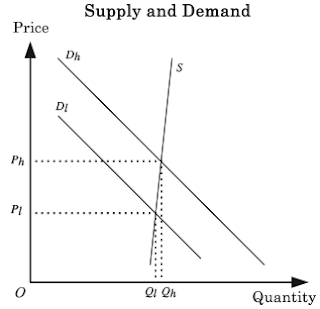Artikel von Emi Koyama, in welchem anhand eines ökonomischen Modells die Auswirkung von "End demand"- Ansätzen auf den Prostitutionsmarkt im unteren Preisbereich beschrieben werden:
(...)"end demand” approach to prostitution, which seeks to reduce demand for commercial sex through public education, prosecution, public humiliation, and other means, may increase prostitution, rather than decrease it, under certain (realistic) conditions.
There are two important assumptions for this claim to be true. First, I assume that prostitution market has extremely low (or negative) downward price elasticity of supply, particularly at the lower end of the market (it makes sense to focus on the lower end, because prostitution market is highly segmented and people at the lower end are the ones most vulnerable to abuse and exploitation), because of lack of viable economic alternatives. Second, I assume that people who trade sex face a trade-off between generating income through sex trade and spending time and energy doing other activities (child-raising, family, community, school, leisure, etc.).
Proponents of “end demand” policies implicitly presume normal (high) elasticity in prostitution market: that is, they believe that a reduction in demand would be met with a comparable reduction in supply, arbitrated by the lower price for sex.
But the supply side of prostitution market (people in the sex trade) are often there in the first place because they lack other viable or comparable economic options, and the reduction of the demand (and hence the price of sex) does not change that circumstance. If many sellers of sex do not have comparable alternatives to selling sex, they will be stuck trading sex for money even if the demand (and hence the price) goes down. That is, supply in prostitution market is downwardly inelastic(...)
“End demand” policies should be rejected because they harm the very people they are intended to help, and does not even succeed at reducing the supply of commercial sex in the long term (and may in fact increase it). Any reduction of demand will be temporary, because as long as there are no other viable economic opportunities, the price will decrease until it reaches a level that can attract enough demand to return. And on top of that, “end demand” policies push away clients (johns) who are relatively safer to work with and draw in those who are most dangerous, as I’ve argued before. The solution to economic desperation and vulnerabilities is to address that economic injustice, not to (make failed attempts to) mask its symptoms.
Hier wird ökonomisch untermauert, was eigentlich schon intuitiv verständlich ist: Wenn es weniger Kunden gibt, entsteht ein Überangebot von Dienstleistern. Gerade im unteren Preisbereich haben viele diesen Beruf ergriffen, weil sie nur sehr begrenzte Möglichkeiten haben- dies wird oft auch von Prostitutionsgegnern argumentiert. Was passiert aber nun mit diesen Menschen? Da sie eben kaum andere Optionen haben, müssen sie länger für das gleiche Einkommen arbeiten, d.h. das Angebot steigt. Damit einhergehend steigt der Konkurrenzdruck, d.h. es werden vermehrt unsafer-Praktiken angeboten und man kann es sich noch weniger als vorher leisten unangenehme oder gar gefährliche Kunden abzulehnen. Dies alles setzt natürlich voraus, dass es tatsächlich weniger Kunden gibt, und sich die Geschäftsanbahnung nicht einfach verlagert, zb. von der Strasse ins Internet.

Keine Kommentare:
Kommentar veröffentlichen